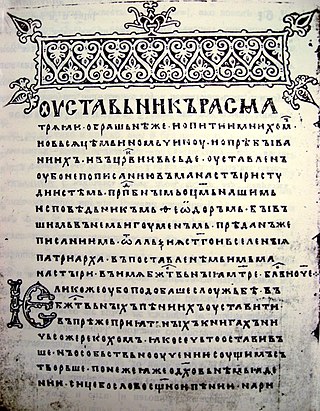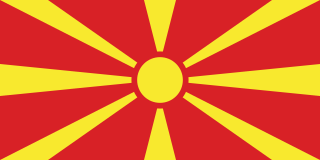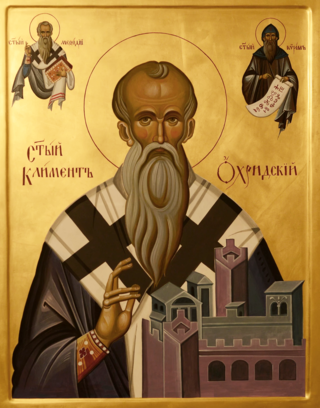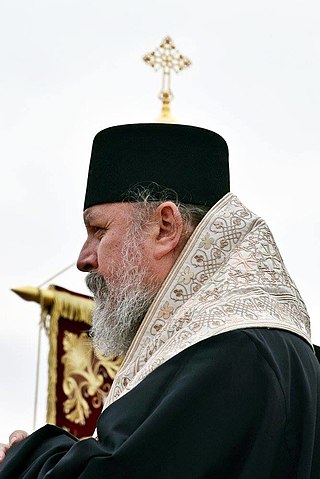
The Cyrillic script, Slavonic script or simply Slavic script is a writing system used for various languages across Eurasia. It is the designated national script in various Slavic, Turkic, Mongolic, Uralic, Caucasian and Iranic-speaking countries in Southeastern Europe, Eastern Europe, the Caucasus, Central Asia, North Asia, and East Asia, and used by many other minority languages.

The Glagolitic script is the oldest known Slavic alphabet. It is generally agreed that it was created in the 9th century for the purpose of translating liturgical texts into Old Church Slavonic by Saint Cyril, a monk from Thessalonica. He and his brother Saint Methodius were sent by the Byzantine Emperor Michael III in 863 to Great Moravia to spread Christianity there. After the deaths of Cyril and Methodius, their disciples were expelled and they moved to the First Bulgarian Empire instead. The Early Cyrillic alphabet, which developed gradually in the Preslav Literary School by Greek alphabet scribes who incorporated some Glagolitic letters, gradually replaced Glagolitic in that region. Glagolitic remained in use alongside Latin in the Kingdom of Croatia and alongside Cyrillic until the 14th century in the Second Bulgarian Empire and the Serbian Empire, and later mainly for cryptographic purposes.

Cyril and Methodius were brothers, Byzantine Christian theologians and missionaries. For their work evangelizing the Slavs, they are known as the "Apostles to the Slavs".

Old Church Slavonic or Old Slavonic is the first Slavic literary language and the oldest extant written Slavonic language attested in literary sources. It belongs to the South Slavic subgroup of the Balto-Slavic branch of the Indo-European language family and remains the liturgical language of many Christian Orthodox churches. Until the reforms of Patriarch Nikon of Moscow between 1652 and 1666, Church Slavonic was the mandatory language of the Russian Orthodox Church.

Great Moravia, or simply Moravia, was the first major state that was predominantly West Slavic to emerge in the area of Central Europe, possibly including territories which are today part of the Czech Republic, Slovakia, Hungary, Austria, Germany, Poland, Romania, Croatia, Serbia, Ukraine and Slovenia. The formations preceding it in these territories were Samo's tribal union and the Pannonian Avar state.

Boris I, venerated as Saint Boris I (Mihail) the Baptizer, was the ruler (knyaz) of the First Bulgarian Empire from 852 to 889. Despite a number of military setbacks, the reign of Boris I was marked with significant events that shaped Bulgarian and European history. With the Christianization of Bulgaria in 864, paganism was abolished. A skillful diplomat, Boris I successfully exploited the conflict between the Patriarchate of Constantinople and the Papacy to secure an autocephalous Bulgarian Church, thus dealing with the nobility's concerns about Byzantine interference in Bulgaria's internal affairs.
The Orthodox Church of the Czech Lands and Slovakia is a self-governing body of the Eastern Orthodox Church that territorially covers the countries of the Czech Republic and Slovakia. The current primate of the Czech and Slovak Orthodox Church is Rastislav of Prešov, Metropolitan of the Czech Lands and Slovakia since 2014.

Naum, also known as Naum of Ohrid or Naum of Preslav, was a medieval Bulgarian writer and missionary among the Slavs, considered one of the Seven Apostles of the First Bulgarian Empire. He was among the disciples of Cyril and Methodius and is associated with the creation of the Glagolitic and Cyrillic script. Naum was among the founders of the Pliska Literary School. Afterwards Naum worked at the Ohrid Literary School. He was among the first saints declared by the Bulgarian Orthodox Church after its foundation in the 9th century. The mission of Naum played significant role by transformation of the local Early Slavs into Bulgarians.

The Ohrid Literary School or Ohrid-Devol Literary school was one of the two major cultural centres of the First Bulgarian Empire, along with the Preslav Literary School. The school was established in Ohrid. Another center was Devol as well as Drembica, Glavinica and Velika with unknown location. All the school centers were located in a then Bulgarian province known as Kutmichevitsa. It was founded in 886 by Saint Clement of Ohrid on the order of Boris I of Bulgaria simultaneously or shortly after the establishment of the Preslav Literary School. After Clement was ordained bishop of Drembica, Velika (bishopric) in 893, the position of head of the school was assumed by Naum of Preslav. The Ohrid Literary School used the Glagolitic alphabet from its establishment until the 12th century and Cyrillic from the end of the 9th century onward. Between 990 and 1015, Ohrid was the capital of the Bulgarian Empire and simultaneously also the seat of the Bulgarian Patriarchate.

May 10 – Eastern Orthodox Church calendar – May 12
Equal-to-apostles or equal-to-the-apostles is a special title given to some saints in Eastern Orthodoxy and in Byzantine Catholicism. The title is bestowed as a recognition of these saints' outstanding service in the spreading and assertion of Christianity, comparable to that of the original apostles.

The Catholic Church in North Macedonia is part of the worldwide Catholic Church, under the spiritual leadership of the Pope in Rome and is one of the major religious communities that exist on the territory of the Republic of North Macedonia. Catholic believers from North Macedonia mostly include Albanians, Macedonians and Croats and are most concentrated in the Skopje Statistical Region and the Southeastern Statistical Region of North Macedonia.

The Church of Saints Clement and Panteleimon is a Byzantine church situated on Plaošnik in Ohrid, North Macedonia. It is attributed to Saint Clement of Ohrid, a disciple of Saint Cyril and Saint Methodius. Archaeologists have come to believe that the church is located on the site where the first students of the Glagolitic alphabet were taught in the First Bulgarian Empire.

Macedonian Canadians are Canadian citizens of ethnic Macedonian descent, who reside in Canada. According to the 2021 census there were 39,440 Canadians who claimed full or partial Macedonian ancestry.

Saint Clementof Ohrid was one of the first medieval Bulgarian saints, scholar, writer, and apostle to the Slavs. He was one of the most prominent disciples of Cyril and Methodius and is often associated with the creation of the Glagolitic and Cyrillic scripts, especially their popularisation among Christianised Slavs. He was the founder of the Ohrid Literary School and is regarded as a patron of education and language by some Slavic people. He is considered to be the first bishop of the Bulgarian Orthodox Church, one of the Seven Apostles of Bulgarian Orthodox Church since the 10th century, and one of the premier saints of modern Bulgaria. The mission of Clement was the crucial factor which transformed the Slavs in then Kutmichevitsa into Bulgarians. Clement is also the patron saint of North Macedonia, the city of Ohrid and the Macedonian Orthodox Church.

The Golden Age of Bulgaria is the period of the Bulgarian cultural prosperity during the reign of emperor Simeon I the Great (889—927). The term was coined by Spiridon Palauzov in the mid 19th century. During this period there was an increase of literature, writing, arts, architecture and liturgical reforms.

The Archbishopric of Moravia was an ecclesiastical province, established by the Holy See to promote Christian missions among the Slavic peoples. Its first archbishop, the Byzantine Methodius, persuaded Pope John VIII to sanction the use of Old Church Slavonic in liturgy. Methodius had been consecrated archbishop of Pannonia by Pope Adrian II at the request of Koceľ, the Slavic ruler of Pannonia in East Francia in 870.

Bishop Naum of Strumica is the Metropolitan of the Diocese of Strumica, Macedonian Orthodox Church – Ohrid Archbishopric.

Saint Angelar was a medieval Bulgarian saint and Slavic enlightened.

The Seven Apostles are seven saints venerated in the Bulgarian Orthodox Church since the 10th century.
















